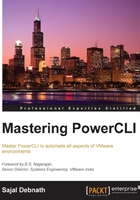
Chapter 3. Deploying vSphere Hosts
In the first chapter, we covered the basics of PowerShell and PowerCLI. Next, we covered various advanced topics, such as writing advanced functions in PowerShell and details of parameters and their different attributes. We also covered how to write help files and handle errors in PowerShell. All the previously mentioned topics were introductory topics so that you could use them to build your own advanced scripts. The primary aim of this book is to master PowerCLI, but for obvious reasons we need to master PowerShell to some extent so that we can build upon that. Since we already covered some part of it (the more advance topics of PowerShell will be covered in the upcoming chapters), let's dive into managing VMware environments using PowerCLI. We will start with the installation and configuration of the ESXi server using PowerCLI. Since there are various ways through which you can install the ESXi server, we will limit our discussion to only the portion that requires extensive use of PowerCLI. Keeping this in mind, in this chapter, we will discuss the following topics:
- Image Builder with PowerCLI
- Using host profiles
- Configuring Auto Deploy for ESXi hosts
- Adding hosts to a vCenter server
Note that vSphere Auto Deploy is a process using which you can automatically deploy an ESXi host, but since vSphere Auto Deploy depends heavily on the vSphere Image CLI Builder and host profiles, we will first cover these two topics and then we will cover Auto Deploy. So let's start.